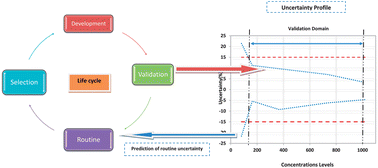An overall uncertainty approach for the validation of analytical separation methods†
Abstract
The aim of this paper is to recommend a new strategy for the analytical validation based on the uncertainty profile as a graphical decision-making tool, and to exemplify a novel method to estimate the measurement uncertainty. Indeed, the innovative formula that we offer to assess the uncertainty is based on the calculation of the β-content tolerance interval. Three chemometric methodologies are exposed to build the (β, γ) tolerance interval, namely: the Satterthwaite approximation, the GPQ method (generalized pivotal confidence) and the MLS procedure (modified large simple). Furthermore, we illustrate the applicability and flexibility of the uncertainty profile to assess the fitness of the purpose of chromatographic and electrophoretic analytical methods, which use different instrumental techniques such as


 Please wait while we load your content...
Please wait while we load your content...